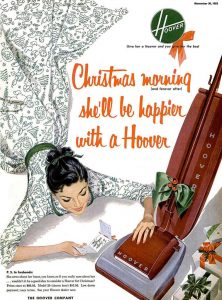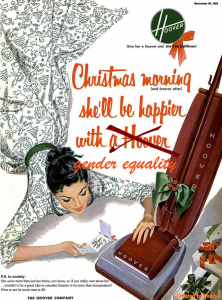GRSJ Cultural Jam
Original Ad:

Analysis of original ad:
This 50’s ad depicts a middle class women being pleased with her new Hoover vacuum from her husband. The overall body language of her lying down on the ground with a gentle caress of her left hand and smile on the face as she reads the Christmas card projects a false pleasure with her new gift on Christmas morning. The woman being placed lying on the floor versus standing up straight beside the vacuum elicits a level of vulnerability furthered with signs of subservience and obligations to duty. What is interesting with this body positioning is that she is placed in a physical position lower than an inanimate object. We are then to wonder how does Hoover see women’s position relative to men if she is less than a red vacuum?
The tagline right below the Hoover company insignia states, “Give her a hoover and you give her the best” implying that women are domesticated individuals where a simple household device is considered monumental in her life. The word “give” signifies that women are incapable of purchasing this product themselves and must rely on the husband’s active duty in “giving” it to her. This sentiment thoroughly negates the idea that women are capable of acquiring jobs or have their own ability to make purchases of their own when in fact they took over men’s jobs while the husbands were dispatched to the front lines during the war. Furthermore, the note at the bottom left of the ad is directed to husbands as it is believed that men are the breadwinners of every family and even posits a question with the intention of eliciting guilt; implying that if the husband does not present this Hoover as a gift, the husband is failing in his role as men, as a provider.
Explicitly, the ad is conveying the idea that wives will be pleased if they are given this product. Implicitly it states that a woman’s place should belong in the domesticated sphere. This ad presents itself as a falsity being that during WWII, women occupied the jobs that their counterparts left behind. These women were able to pick up “men’s work” and continue to uphold the society with images of “Rosie the Riveter” as an iconic representation. Yet when men return home after the war, women were relegated back to their domesticated lives as housewives and homemakers. The disenfranchising of women is then portrayed in this 1950s ad where products are used to compensate for reducing women’s role to the domestic realm.
Jammed version:

Jamming Philosophy:
The jammed version of the ad seeks to reveal the truth behind the notion that women are more than their societal restraints and to also challenge the cultural norm presented by the original ad. The changing of the tag line to “Give her a hoover and she’ll be indifferent” showcases the lack of concern women have with receiving a brand new vacuum. The “best” for a woman is not to receive a product that further perpetuates the male desires of domestication. Instead we are to consider the various economical and societal values that women may wish to engage with. There is a disjunction between the actual role women carry during this period and the role in which they envision and by crossing out “a Hoover” in “Christmas morning (and forever after) she’ll be happier with a Hoover” and replaced with “gender equality”, I hope to remove the false representation of women’s aspirations.
Furthermore, I have changed the small note at the bottom of the ad; instead of addressing it only to “husbands”, I address it to “society” because we must speak to the society as a collective whole in order to challenge the economical values of being American and being a White male. Included in this note, I also posited the same method of eliciting guilt by asking for the society to consider the possibility that perhaps women would like to be more than just homemakers or housewives and to also broaden the perception that not only men can be the ideal workers/leaders/thinkers. The incorporation of the sarcastic undertone in putting a price besides the concept of not being a sexist hopes to invoke an alternate ideology to the patriarchal society during the 50s. I also would have liked to position the woman to stand beside her new product versus lying down where her stature is taller than the vacuum, but due to my lack of skills in photoshop I can not produce that. Overall with this jammed ad I seek to challenge the gender dystopia that was prevalent during the era and to bring forth a new conversation about gendered ideas.